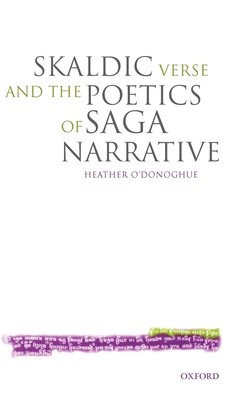
- We will send in 10–14 business days.
- Author: Heather O'Donoghue
- Publisher: Oxford University Press, USA
- ISBN-10: 0199267324
- ISBN-13: 9780199267323
- Format: 14 x 21.6 x 1.9 cm, kieti viršeliai
- Language: English
- SAVE -10% with code: EXTRA
Skaldic Verse and the Poetics of Saga Narrative (e-book) (used book) | bookbook.eu
Reviews
Description
Skaldic Verse and the Poetics of Saga Narrative is a study of the varying relationships between verse and prose in a series of Old Norse-Icelandic saga narratives. It shows how the interplay of skaldic verse, with its metrical intricacy and cryptic diction, and saga prose, with its habitual spare clarity, can be used to achieve a wide variety of sophisticated stylistic and psychological effects. In sagas, there is a fundamental distinction between verses which are ostensibly quoted to corroborate what is stated in the narrative, and verses which are presented as the speech of characters in the saga. Corroborative verses are typical of, but not confined to, historical writings, the verses acting as a footnote to the narrative. Dialogue verses, with their illusion that saga characters break into verse at crucial points in the story, belong to the realm of fiction. This study, which focuses on historical writings such as Ãgrip and Heimskringla, and three of the major family sagas,Eyrbyggja saga, Gisla saga and Grettis saga, shows that a close reading of the prosimetrum in the narrative can be used to chart the complex and delicate boundaries between history and fiction in the sagas. When skaldic stanzas are presented as the dialogue of saga characters, the characteristic naturalism of these narratives is breached. But some saga authors, as this book shows, extend still further the expressiveness of saga narrative, presenting skaldic stanzas as the soliloquies of saga characters. This technique enables the direct articulation of emotion, and hence dramatic focalization of the narrative and the creation of psychological climaxes. As an epilogue, Heather O'Donoghue considers the absence of such effects in Hrafnkels saga--a highly literary narrative without verses.
EXTRA 10 % discount with code: EXTRA
The promotion ends in 23d.18:12:29
The discount code is valid when purchasing from 10 €. Discounts do not stack.
- Author: Heather O'Donoghue
- Publisher: Oxford University Press, USA
- ISBN-10: 0199267324
- ISBN-13: 9780199267323
- Format: 14 x 21.6 x 1.9 cm, kieti viršeliai
- Language: English English
Eyrbyggja saga, Gisla saga and Grettis saga, shows that a close reading of the prosimetrum in the narrative can be used to chart the complex and delicate boundaries between history and fiction in the sagas. When skaldic stanzas are presented as the dialogue of saga characters, the characteristic naturalism of these narratives is breached. But some saga authors, as this book shows, extend still further the expressiveness of saga narrative, presenting skaldic stanzas as the soliloquies of saga characters. This technique enables the direct articulation of emotion, and hence dramatic focalization of the narrative and the creation of psychological climaxes. As an epilogue, Heather O'Donoghue considers the absence of such effects in Hrafnkels saga--a highly literary narrative without verses.


Reviews